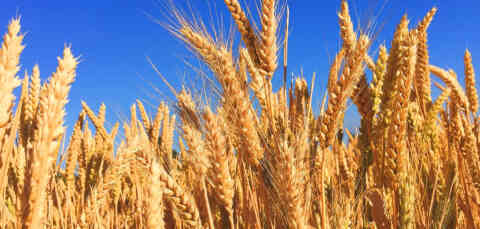Wheat

Wheat is the grain from which most flour in the UK is made. We are all familiar with the principle of grape varieties producing wine with different characteristics, and with grapes being blended to produce wines. Similarly, millers are highly trained and use their knowledge and skill to assess and blend different wheat varieties to produce flour to the exact specification required by each customer and which best suits the end purpose. Flour used in a burger bun is different to the flour used for pizzas, and different again to flour used in the crumb coating of a fishfingers or for biscuits.
Wheat varieties grown in the UK must be approved through a government backed testing system and included on the National List. Flour millers work with plant breeders to assess new varieties for their bread making quality and other end use characteristics.
This assessment is then included in the AHDB Recommended List (RL). This is an independent assessment of how new varieties perform aimed mainly at farmers, but wheats are also classified as to their suitability for end use (see table).
Each year, UK Flour Millers produces a Wheat Guide that outlines the milling industry's views on milling wheat varieties.
Click here for more information on the AHDB Recommended List from their website.
For milling industry comments on RL wheat varieties, please see our Wheat Guide 2025
Developing new wheat varieties
Providing food and nourishment for the nation is a skilled and complex job. Flour millers take an active role in research and development of wheat varieties and milling processes to ensuring they can produce flour in the required quantities and of the highest quality to feed and nourish the nation.
There are about 50 different wheat varieties grown commercially in the UK. Development of new varieties is an ongoing process and serves a range of purposes. A new variety might be developed to improve yield or disease resistance, but equally it could be to increase the nutritional quality for example by boosting fibre levels.
Milling homegrown wheat
In order to maintain steady supplies of flour, millers need a steady supply of sustainable and affordable wheat. Having access to suitable homegrown grain is paramount. Most of the wheat that UK flour millers use is grown in the UK – in a typical year around 85% is homegrown. A small percentage of wheat is imported from North America and Europe as these have characteristics and qualities that aren’t found in wheats grown in the UK due to differences in climate and soil.
This is a success story for all participants in the cereals supply chain who, following the second world war, set out to increase the level of homegrown wheat used. Until the 1970s, the UK was reliant on imported wheat for bread varieties, and even imported large quantities of flour. However, a joint effort by plant breeders, farmers, millers, and bakers to develop, grow, mill, and bake suitable varieties in the UK saw levels of homegrown wheat usage double in just 15 years. Today, millers use more than 5 million tonnes of home-grown wheat each year, compared with under 2 million tonnes in the early 1970s.

